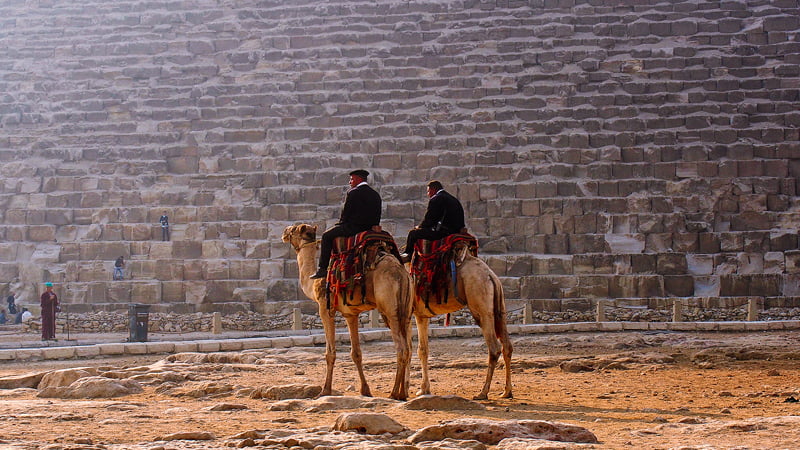In the heart of the Giza Plateau in Egypt stands an awe-inspiring wonder that has captured the imagination of generations – the Pyramid of Khafre. This ancient structure, dating back over 4,500 years, is a testament to the ingenuity and skill of the ancient Egyptians. But beyond its grandeur, the Khafre conceals numerous mysteries that baffle archaeologists and historians.
In this comprehensive article, we embark on a journey to unravel the enigmas of the Khafre. We delve into every facet of this iconic monument, from its historical background to its construction techniques, theories surrounding its purpose, and the captivating legends that have endured. Join us as we explore the Pyramid of Khafre and shed light on its profound significance in ancient Egypt.
The Pyramid of Khafre, A Testament to Ancient Engineering

Standing at approximately 143.5 meters (471 feet), the Pyramid of Khafre was built during the Fourth Dynasty of the Old Kingdom of Egypt. It was constructed for Pharaoh Khafre (also known as Khafra or Chephren), the ruler of ancient Egypt from 2558 to 2532 BC. It holds immense historical and cultural importance as the second-largest Pyramid on the Giza Plateau.
The Pyramid’s Architecture, A Marvel of Precision
The Pyramid of Khafre is a masterpiece of ancient engineering, exhibiting extraordinary precision and alignment. Its base covers an area of around 10.5 acres, and each side faces the cardinal points (north, south, east, and west) with remarkable accuracy. This impeccable alignment has astounded researchers, leading to speculations about the ancient Egyptians’ profound astronomical knowledge.
The Sphinx Connection: A Symbolic Guardian
Adjacent to the Khafre, we find the majestic Sphinx, a mythical creature with a lion’s body and a human’s head. The Sphinx is believed to represent Pharaoh Khafre and serves as a guardian of his Pyramid. The interplay between the Sphinx and the Pyramid adds to this ancient site’s enigmatic aura.
The Mysteries Surrounding the Pyramid of Khafre

While the Pyramid of Khafre has been extensively studied, it keeps many of its secrets hidden. Archaeologists and historians have formulated various theories and hypotheses to explain the Pyramid’s purpose and significance.
Purpose and Function, A Tomb or Something More?
The primary theory about the Pyramid’s purpose is that it served as a monumental tomb for Pharaoh Khafre. An elaborate burial chamber was discovered inside the Pyramid, complete with a coffin. However, some scholars believe the Pyramid held a more profound symbolic significance, possibly related to the afterlife and the pharaoh’s divine role.
Solar Observatory Hypothesis, Aligning with the Heavens
A lesser-known theory suggests that the Pyramid of Khafre was a sophisticated solar observatory. According to this hypothesis, the Pyramid’s shafts were strategically aligned to observe celestial events, such as solstices and equinoxes. This would indicate a deeper understanding of astronomy and its connection to religious practices.
Encoded Mathematical Knowledge, Hidden Numerical Patterns
Some researchers propose that the Pyramid encodes advanced mathematical knowledge. The proportions and dimensions of the structure supposedly contain numerical patterns with mystical significance, hinting at the ancient Egyptians’ advanced mathematical understanding.
The Magnificence of Construction, Building the Pyramid of Khafre

The construction of the Pyramid of Khafre remains awe-inspiring, considering the limited technology available to the ancient Egyptians.
Building Materials, From Quarries to Construction
The Pyramid of Khafre was built using massive limestone blocks quarried locally. These blocks were hauled to the construction site and precisely stacked to form the Pyramid’s core. The outer casing stones were also made of finer white limestone, giving the structure its original dazzling appearance.
Techniques and Labor, A Monumental Undertaking
Constructing the Pyramid required an astounding amount of labor and engineering expertise. It is believed that thousands of skilled laborers, including artisans, artisans, and engineers, were involved in this colossal project. Their ingenuity and dedication were paramount in creating a monument that has withstood the test of time.
Theories, Legends, and Controversies, Unraveling the Mystique
Over the centuries, the Khafre has been the subject of numerous legends and controversies, adding to its mystique and allure.
The Curse of the Pharaohs, Fact or Fiction?
One of the most enduring legends surrounding the Pyramid is the infamous “Curse of the Pharaohs.” According to popular belief, those who defile or disturb the resting place of Pharaohs would face dire consequences and misfortunes. We explore the origins of this myth and examine its historical accuracy.
The Missing Capstone, Symbolism, or Structural Damage?
The Khafre is missing its uppermost capstone, prompting speculation about its significance. Was it symbolic of a divine connection, or did practical reasons cause its absence? We delve into the various theories surrounding the missing capstone.
Exploring the Interior, Journey into the Pyramid

Venturing inside the Pyramid of Khafre reveals a complex network of chambers and passageways that has fascinated explorers for centuries.
The Descending Passage, The Gateway to the Underworld
Upon entering the Pyramid, visitors encounter the Descending Passage, leading deep into the Pyramid’s core. This eerie passage is believed to represent the journey to the underworld and the afterlife, a symbolic passage for the deceased pharaoh.
The Great Hall, A Magnificent Gallery
As explorers venture further into the Pyramid, they encounter the Great Hall, an impressive gallery with a high gabled roof. The grandeur of this hall suggests its importance in ancient rituals and ceremonies.
FAQs
What is the Pyramid of Khafre’s significance in ancient Egypt?
The Pyramid of Khafre held immense importance in ancient Egyptian culture, serving as a burial monument for Pharaoh Khafre and symbolizing his divine connection and eternal afterlife.
How long did it take to construct the Pyramid of Khafre?
The construction of the Pyramid of Khafre is estimated to have taken around 20 years, a remarkable achievement considering the ancient technology available at the time.
Are any hidden chambers or passages yet to be discovered in the Pyramid of Khafre?
Archaeologists continue to explore the Pyramid, and there are possibilities of undiscovered rooms or obscure passages within the structure.
What makes the Pyramid of Khafre unique compared to other pyramids in Egypt?
The Pyramid of Khafre stands out due to its impressive alignment, proximity to the Great Sphinx, and the exquisite outer casing stones once adorned its surface.
Can visitors explore the interior of the Pyramid of Khafre today?
Yes, the interior of the Pyramid of Khafre is open to visitors. However, some areas might be restricted for preservation and safety reasons.
How has the Pyramid of Khafre influenced modern architecture and culture?
The Pyramid of Khafre has inspired various architectural designs and cultural representations, showcasing its enduring impact on human creativity and imagination.
Conclusion
As we conclude our expedition into the mysteries of the Pyramid of Khafre, we marvel at this ancient marvel’s ingenuity and cultural significance. From its awe-inspiring architecture to the enigmatic legends that surround it, the Pyramid of Khafre continues to captivate the world. It symbolizes ancient Egyptian civilization and a testament to the human spirit’s quest for knowledge and legacy.




